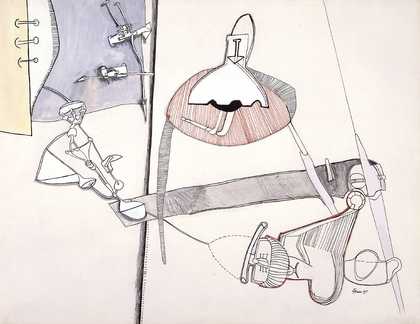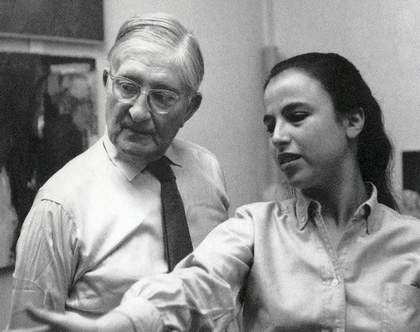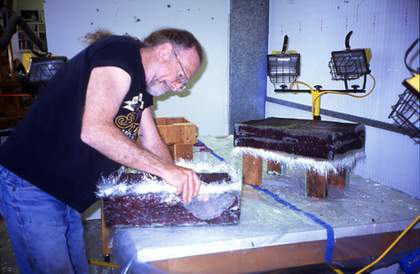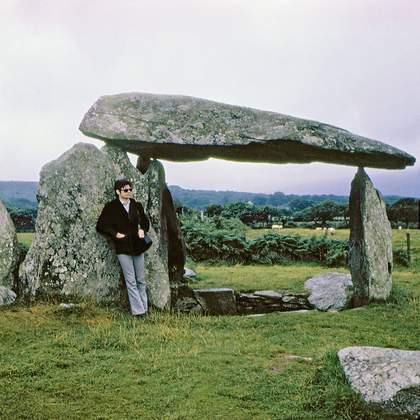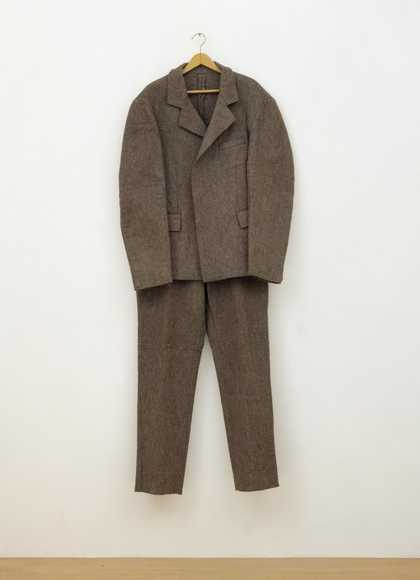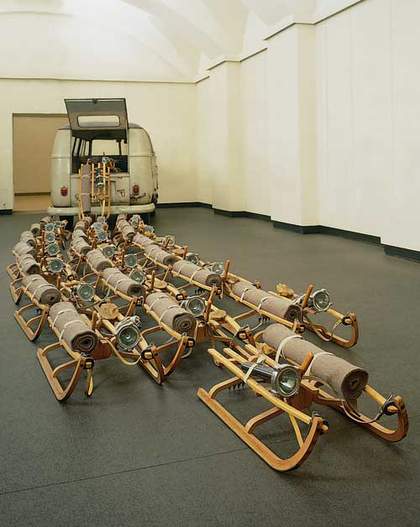The problems that particularly interest me are those posed by the conservation or replication of works whose ephemerality is integral to their identity and conception. What attempts should be made, if any, to preserve the material integrity of such work, or of its residues if it was a performance or action? This might seem to be primarily an ethical issue, having to do with respecting an artist’s intentions, or, where evidence of this is lacking, with respecting what we now take to be the artistic integrity of a work and its inherent ephemerality. However, the situation is rarely clear-cut. What we know of an artist’s intentions can be deeply contradictory. Many twentieth-century artists who espoused an ethic of ephemerality, such as those involved with the happenings of the earlier 1960s, often took considerable pains to preserve records or collateral evident relating to their event-based work.
Allan Kaprow, for example, was quite explicit that his happenings were to be seen as one-off events that could not be embodied in any lasting object that might be shown in a museum, and persisted only in participants’ memory and in the ramifications that the experience of a happening had for them. At the same time, he created an elaborate archive where he kept the scores of his happenings, photographs taken at them by professional art photographers such as Peter Moore (including an abundance of contact sheets as well as prints of chosen images), cuttings from the few published reviews, notes he made for talks he gave prior to a happening, and occasional letters to critics where he elaborated on the conception and staging of a happening. In many instances, though not in Kaprow’s case, selected objects deployed in actions or happenings were retained by an artist and presented as object-based art works that often took a form that was evocative of the ephemeral nature of the event in which they once had played a role. Several well known works by Joseph Beuys and Claes Oldenburg are both objects and residues of events in this way.
There is a larger issue at stake here – namely that, for an art work to endure, some aspect or trace of it has to survive in reasonably permanent material form, however integral ephemerality was both to its original conception, and to the way in which we might make sense of it now. Such work might be characterised by the oxymoron ‘enduringly ephemeral’, leaving us with no clear answers as to what special measures we should take to halt the degradation of its ephemeral traces, and to preserve surviving records of it. Where a work was conceived and realised largely as an event, and left behind no material object, it inevitably begins to take the form of the surviving traces and records we have of it, whether visual or verbal, becoming in effect another constellation of material entities that themselves are subject to physical decay.
The way to confront these dilemmas is to work with them and not seek a clear-cut ethical or aesthetic solution – because there is none. Rather, we need to recognise that complexities and contradictions will persist in any present-day attempts to conserve such inherently ephemeral work and make it publicly available. A curator or an art historian who is convinced of the value of such work will inevitably be committed to presenting it in public, and doing so in a way that has a certain vividness and immediacy. This may require conservation of photographs that are beginning to degrade, or of residual objects that were not originally designed to be permanent, or even of texts, thereby seeking to ensure that the material remains and archival records that do survive can be presented in a form that make the work come alive for a present-day audience. At the same time, these efforts need to recognise their paradoxical and contradictory status – that they can never actually reconstitute the work or make it fully present to us now. The materials offered up to the viewer are possibly the more effective for testifying to their relative inadequacy, to their provisional and contingent nature (what survives and how it survives is inevitably subject to accident, and this is part of the work’s ephemerality). If they failed to do so, and seemed to be endowed with a definitive status, they would gainsay something integral to the work they were seeking to reconstitute.
This is not only true of work whose materiality or phenomenality is unconditionally ephemeral – namely events or situations that can only be re-presented indirectly, or works whose material make up was deliberately such that they would deteriorate and play out a process of collapse or decay (such as Smithson’s Partially Buried Woodshed). A lot of art work that took the form of a relatively permanent object was designed to strike the viewer as provisional rather than definitive. In such cases, too painstaking a restoration of a work that has suffered degradation over time can confer on it a false air of numinous permanence that is at odds with its conception. Equally, too perfect a restoration can make a work composed of relatively ‘shabby’ materials look dead, just as happens with too thoroughly renovated a face ‘restored’ by plastic surgery.
The issue of replicas is a core concern of this workshop. Problems of a similar nature to the ones I have been identifying present themselves when it comes to making replicas of works that were designed to strike one as relatively casual, improvised creations, works that in their very make-up sought to gainsay the pretensions to monumentality and permanence characteristic of traditional large-scale sculpture. Eva Hesse’s latex-based and even fibreglass work would fall into this category. In this case the deterioration was not deliberately intended, and the materials have decayed and discoloured in ways that are tangential to the conception of the works in which they were incorporated. At the same time, however, the relative frailty of latex in particular, and the sense that both the latex and fibreglass give of being deployed in a relatively open and freely improvised way – one is made very aware of the fluid form they had before they set – makes the substance of these materials particularly appropriate to conception of Hesse’s work. In the discussion generated by the 2002–3 Hesse retrospective, it was suggested that replicas might legitimately be made and displayed alongside severely deteriorated works, leaving the viewer to mediate between the two different representations of the same work. Certainly, this strategy would make a viewer clearly aware of the complexities and limits of replica making.
As a tactic, it might seem to have a lot to recommend it, up until the point perhaps where the original work had degraded to a degree that it was little more than a meaningless pile of dust and rubble. At this juncture, the replica would probably need to be redesignated a reconstruction, and given a status not dissimilar to the reconstructions attempted from photographic images of lost works, such as Tatlin’s corner reliefs. Such reconstructions always make more sense, and possibly become more intriguing and evocative, when seen in relation to the evidence on which they were based – which in the case of a completely deteriorated Hesse work would be photographs of the work in its original state, and possibly too in its relatively well-preserved state when the replica was made. This said, Hesse’s work, whatever Sol LeWitt claimed, was hand-made and the irregularities of the accidents of its fabrication were integral to it. Whether a work was made by Hesse herself, or by assistants working on her instructions and directly under her supervision, the material processes that took place at the moment of its realisation were part of its very substance, just as much as is the case for any improvised, process-based painting. A replica in the substantive sense of the term would be impossible to produce, and any attempt to create one could at best be a re-enactment or experiment that would not in any way be able to stand in for the original work.
The Naum Gabo sculptures, that are a particularly significant case study for this workshop, present issues of rather a different nature, in that issues of ephemerality did not play a significant role in the artist’s conception of his work. Plastic was chosen for practical reasons, but also because at the time, it was a material that seemed to represent an almost timelessly present modernity. Gabo’s works in plastic have aged in two ways, firstly through literal deterioration, and secondly because the plastic elements even in their original state, particularly in the earlier works, do not have the clean-cut perfection of form that modern perspex work has, and so no longer have the air of ultra-modernity they once possessed. Instead, they can almost look a little tackily hand-made (and as such acquire a slightly dowdy artisanal charm at odds with their original conception). This poses some interesting questions about the degree to which a replica should be made to look ‘new’, if at all. Should the replica seek to recreate for a contemporary audience the look of ultra- modernity the original work once had, or should it present itself as being more in the nature of a relic of such modernity? It strikes me that some pretty delicate decisions have to be made all along the way, that admit of no definitive solution. After seeing a carefully reconstituted replica displayed beside a buckling original Gabo sculpture at the workshop, it struck me that this display added to the interest of the work by Gabo. It created the effect of what almost amounted to a new work that set the irregularities of natural decay against the clean-cut geometry the Gabo clearly had before the plastic started deteriorating.
In this case, by contrast with Hesse, the process of fabrication made replication much more possible, as the original work was assembled from flat pieces of plastic whose outline can now be reconstructed more or less exactly (the replica could be produced rather as a dress can be assembled from pieces of cloth cut to a template recorded in a pattern book) – though there were still some small details whose exact reproduction eluded the model maker. Even in this case, where a hand-made touch was irrelevant to the original process of fabrication, there can be no such thing as a perfect replica. Once the original work deteriorates, it is lost, and we are left with models and photographs that give us an idea of what the work might have been like, but not a substitute for the work itself.
By way of conclusion, I should like to reiterate a point that was made by several speakers at the workshop (though it met with opposition from some). Given the post-conceptual understanding of the art work that is widely taken for granted in the art world nowadays, and given the amount of significant twentieth-century art that is constitutively ephemeral, and can only be preserved through traces, records and in some cases models, it has become legitimate for art museums to see themselves as housing a relatively heterogeneous array of objects. These can range from objects hand-made by an artist, to ones produced by fabricators on the instructions of an artist, to documentary records and replicas of works that no longer exist in the form in which they were originally enacted. This has radically shifted the ethics of replication, both making the possibility of showing replicas much less contentious, but also creating a climate where particular care has to be taken to specify the status of any replicas being shown.
There was a consensus that replicas should be exhibited with a clear statement about their status and some information about the evidence that guided their making. Nowadays, we are acutely aware that an object we see in a museum may not be the work of art as such, and that the latter can exist as a partly conceptual phenomenon that we as viewers need to reconstitute in our minds from the visual material that has been put on show. This in turn means that as visitors to a museum, we feel we need to be made clearly aware of the status of replicas of lost or degraded works, so we do not see these as being works of art in themselves, but as material from which we can project what some lost work might have been. We view the replica in a frame of mind somewhat akin to the one we adopt when viewing the object-base element of a conceptual work. As a consequence, the days of a relatively free and easy attitude existed towards replicas of famous lost masterpieces of modern art (such as Tatlin’s Monument to the Third International) are gone, just as much as those of outright opposition to showing anything other than ‘original’ work hand-made by an artist in a museum. This said, I am aware that replicas can under certain circumstances gain a status as works of art in their own right, in the way that for example the Greco-Roman copies or recreations of famous lost masterpieces of early Greek art did in the past.

